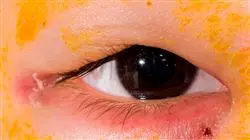University certificate
The world's largest faculty of nursing”
Introduction to the Program
Acquire the necessary skills to work in nursing in the best ophthalmology units with a high intensity Postgraduate diploma"

The work of the nursing professional is developed in multiple and different areas of intervention. From the patient's reception and accompaniment to, the moment of treatment application and follow; up control, the nursing staff must have the capacity of a multifunctional worker.
This is also essential in the Ophthalmic Nursing The nursing professional requires a solid specialization that qualifies them in the work areas in which they are going to develop their work. This performance is also affected by the constant technical and technological advances in this field, which means that professionals must be attentive to all updates so as not to become outdated at great speed.
However, achieving this update requires a dedication that is not always compatible with real life.
This complete Postgraduate diploma has managed to reconcile the intensity of a very complete program, which covers all the essential aspects of the specialization of an expert in ophthalmic nursing, with the daily life of any professional, even those who are in practice.
Through a study approach that takes advantage of the most efficient teaching formulas and the most useful and versatile online systems, this Postgraduate diploma is a highly qualified tool that will take you, step by step, at your own pace but without delay, to the most demanding educational goal.
A luxury program that we put within your reach with the best conditions of the educational market.
With this Postgraduate diploma you will be able to combine high-intensity training with your professional and personal life, achieving your goals in a simple and real way"
This Postgraduate diploma in Ocular Pathology contains the most complete and up-to-date scientific program on the market. Its most notable features are:
- The latest technology in online teaching software
- A highly visual teaching system, supported by graphic and schematic contents that are easy to assimilate and understand
- Practical cases presented by practising experts
- State-of-the-art interactive video systems
- Teaching supported by telepractice
- Continuous updating and recycling systems
- Autonomous learning: full compatibility with other occupations
- Practical exercises for self-evaluation and learning verification
- Support groups and educational synergies: questions to the expert, debate and knowledge forums
- Communication with the teacher and individual reflection work
- Content that is accessible from any fixed or portable device with an Internet connection
- Supplementary documentation databases are permanently available, even after the course
A program created and directed by professional experts in Ophthalmic Nursing that make this Postgraduate diploma a unique opportunity for professional growth”
Our teaching staff is made up of professionals from different fields related to this specialty. In this way TECH ensures that it delivers the targeted capacitive update it intends. A multidisciplinary team of professionals, trained and experienced in different environments, who will cover the theoretical knowledge in an efficient way, but, above all, will bring the practical knowledge derived from their own experience to the course: one of the differential qualities of this course.
This mastery of the subject is complemented by the effectiveness of the methodological design of this Postgraduate diploma in Ocular Pathology. Developed by a multidisciplinary team of experts who integrate the latest advances in educational technology. In this way, you will be able to study with a range of comfortable and versatile multimedia tools that will give you the operability you need in your training.
The design of this program is based on Problem-Based Learning: an approach that views learning as a highly practical process. To achieve this remotely, telepractice will be used. With the help of an innovative interactive video system andlearning from an expert will be to acquire the knowledge as if you were facing the scenario you are learning at that moment. A concept that will allow you to integrate and fix learning in a more realistic and permanent way.
The learning of this Postgraduate diploma is developed through the most advanced didactic means in online teaching to guarantee that your effort will have the best possible results"

Our innovative telepractice concept will give you the opportunity to learn through an immersive experience, which will provide you with a faster integration and a much more realistic view of the contents: “learning from an expert”
Why study at TECH?
TECH is the world’s largest online university. With an impressive catalog of more than 14,000 university programs available in 11 languages, it is positioned as a leader in employability, with a 99% job placement rate. In addition, it relies on an enormous faculty of more than 6,000 professors of the highest international renown.

Study at the world's largest online university and guarantee your professional success. The future starts at TECH”
The world’s best online university according to FORBES
The prestigious Forbes magazine, specialized in business and finance, has highlighted TECH as “the world's best online university” This is what they have recently stated in an article in their digital edition in which they echo the success story of this institution, “thanks to the academic offer it provides, the selection of its teaching staff, and an innovative learning method aimed at educating the professionals of the future”
A revolutionary study method, a cutting-edge faculty and a practical focus: the key to TECH's success.
The most complete study plans on the university scene
TECH offers the most complete study plans on the university scene, with syllabuses that cover fundamental concepts and, at the same time, the main scientific advances in their specific scientific areas. In addition, these programs are continuously being updated to guarantee students the academic vanguard and the most in-demand professional skills. In this way, the university's qualifications provide its graduates with a significant advantage to propel their careers to success.
TECH offers the most comprehensive and intensive study plans on the current university scene.
A world-class teaching staff
TECH's teaching staff is made up of more than 6,000 professors with the highest international recognition. Professors, researchers and top executives of multinational companies, including Isaiah Covington, performance coach of the Boston Celtics; Magda Romanska, principal investigator at Harvard MetaLAB; Ignacio Wistumba, chairman of the department of translational molecular pathology at MD Anderson Cancer Center; and D.W. Pine, creative director of TIME magazine, among others.
Internationally renowned experts, specialized in different branches of Health, Technology, Communication and Business, form part of the TECH faculty.
A unique learning method
TECH is the first university to use Relearning in all its programs. It is the best online learning methodology, accredited with international teaching quality certifications, provided by prestigious educational agencies. In addition, this disruptive educational model is complemented with the “Case Method”, thereby setting up a unique online teaching strategy. Innovative teaching resources are also implemented, including detailed videos, infographics and interactive summaries.
TECH combines Relearning and the Case Method in all its university programs to guarantee excellent theoretical and practical learning, studying whenever and wherever you want.
The world's largest online university
TECH is the world’s largest online university. We are the largest educational institution, with the best and widest online educational catalog, one hundred percent online and covering the vast majority of areas of knowledge. We offer a large selection of our own degrees and accredited online undergraduate and postgraduate degrees. In total, more than 14,000 university degrees, in eleven different languages, make us the largest educational largest in the world.
TECH has the world's most extensive catalog of academic and official programs, available in more than 11 languages.
Google Premier Partner
The American technology giant has awarded TECH the Google Google Premier Partner badge. This award, which is only available to 3% of the world's companies, highlights the efficient, flexible and tailored experience that this university provides to students. The recognition as a Google Premier Partner not only accredits the maximum rigor, performance and investment in TECH's digital infrastructures, but also places this university as one of the world's leading technology companies.
Google has positioned TECH in the top 3% of the world's most important technology companies by awarding it its Google Premier Partner badge.
The official online university of the NBA
TECH is the official online university of the NBA. Thanks to our agreement with the biggest league in basketball, we offer our students exclusive university programs, as well as a wide variety of educational resources focused on the business of the league and other areas of the sports industry. Each program is made up of a uniquely designed syllabus and features exceptional guest hosts: professionals with a distinguished sports background who will offer their expertise on the most relevant topics.
TECH has been selected by the NBA, the world's top basketball league, as its official online university.
The top-rated university by its students
Students have positioned TECH as the world's top-rated university on the main review websites, with a highest rating of 4.9 out of 5, obtained from more than 1,000 reviews. These results consolidate TECH as the benchmark university institution at an international level, reflecting the excellence and positive impact of its educational model.” reflecting the excellence and positive impact of its educational model.”
TECH is the world’s top-rated university by its students.
Leaders in employability
TECH has managed to become the leading university in employability. 99% of its students obtain jobs in the academic field they have studied, within one year of completing any of the university's programs. A similar number achieve immediate career enhancement. All this thanks to a study methodology that bases its effectiveness on the acquisition of practical skills, which are absolutely necessary for professional development.
99% of TECH graduates find a job within a year of completing their studies.
Postgraduate Diploma in Ocular Pathology
Ocular pathology is a fascinating and vitally important field in eye health care. Studying it allows us to understand the complexities of diseases and disorders that affect the eyes and vision, as well as to develop effective strategies for diagnosis and treatment. Would you like to gain the necessary knowledge to specialize in this field? TECH Global University has the ideal program for you. The Postgraduate Diploma in Ocular Pathology is a high-level Postgraduate Diploma that will help you fulfill this purpose in a dynamic and efficient way. To make this training a unique and easily accessible experience, we have structured all classes in a 100% online format, where you will be able to flexibly schedule them according to your needs and have at your disposal state-of-the-art multimedia content. As you progress through the program, you will have access to the latest technological advances in the field of ocular pathology (optical coherence tomography, laser surgery), allowing you to stay abreast of the most cutting-edge techniques in ophthalmic practice.
Become an expert in Ocular Pathology
This Postgraduate Diploma represents a unique opportunity to immerse yourself in the fascinating field of vision and understand the challenges and disorders that can affect it. Here, we will provide you with a solid foundation of knowledge in ocular pathology, allowing you to explore the mysteries behind eye diseases. We have the endorsement of experts in the field, who serve as instructors through a 100% online methodology, in which you can combine your learning with other activities, given the flexible schedule and ease of access from any device connected to the internet. Throughout the program, you will have the opportunity to learn from experts in the field of ophthalmology and ocular research. Thus, you will delve into the world of diseases such as glaucoma, cataracts, macular degeneration and many other common eye conditions. In addition, you will understand the causes, symptoms, diagnostic methods and the most advanced treatment options for each pathology.







